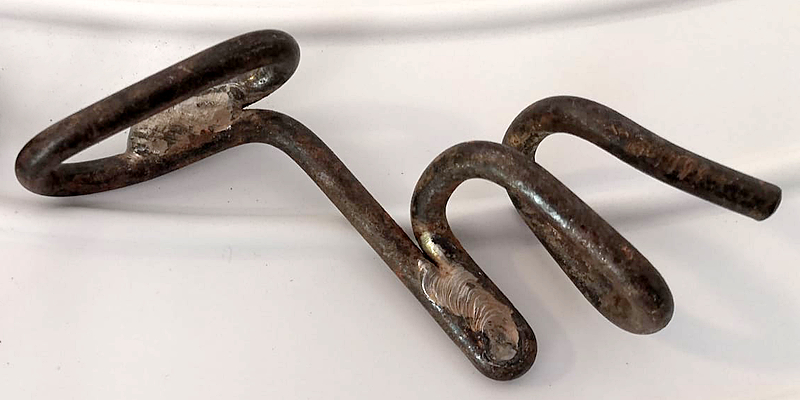Technical Details
I acquired my Scagliarini Cavatappi from Sergio Matteoli in 2022.
My Cavatappi is 123 mm. tall, 51 mm. wide, 50 mm. thick, and weighs 151 g.
My Cavatappi was made from three pieces of 7 mm steel rod bent. One rod was bent into a, oval link with a 15 by 41 mm. opening, the second into a 115 by 41 mm. "L" shape, and the third into a flattened helix with an oval 16 by 26 mm. axial opening. The three pieces were then welded together and then plated.
There are no permanent markings on the Cavatappi.
In the summer of 2021, Roberto Tronconi posted two photos on Facebook of “L'OGGETTO MISTERIOSO” (the Mysterious Object) from the 1970s, and his post was shared to the Speleo Vintage group. Group members quickly identified it as the Cavatappi (Corkscrew) designed by Ettore Scagliarini of Bologna, Italy. In the comments to Roberto’s posts, Sergio Matteoli mentioned that he had several of these. I wrote to Sergio, and he graciously sent this one to me.
I found more information about the Cavatappi on the Gruppo Speleologico di Bologna website (posted April 23, 2020). Roughly translated, it says the following:
THE CORKSCREW DESCENDER
Latest invention. Instead of using the pulley system, I used the logic of winding and unwinding the rope which, entering a ring of suitable dimensions, was inserted into a spiral of treated steel rod into which it was inserted into a carabiner hooking to the harness. Neither the rope nor the carabiner could accidentally come out.
The weight and size were very modest, the cost was adequate and the Kr equal to or higher than that of the rope used. For some time it was the descender most used by many speleos. A few years ago we did some thermal tests on the heating of various types of descenders and it turned out to be the one that warmed the nylon the least.
The reason? The principle of operation was not exclusively related to the friction surface.
 The Cavatappi that Sergio sent me was made by welding three pieces together, while the Cavatappis in Roberto’s post were made from a single continuous rod bent and welded, so there are variations on the design.
The Cavatappi that Sergio sent me was made by welding three pieces together, while the Cavatappis in Roberto’s post were made from a single continuous rod bent and welded, so there are variations on the design.
My Cavatappi is heavily worn, despite being steel, and the rope path is obvious from the wear marks if nothing else. The corkscrew can be attached to the seat carabiner without opening the ‘biner, and the rope can be rigged without removing the Cavatappi.

For far more content, use a larger monitor and a full-width window.
Hundreds of cell phone users complained and asked me to for a simpler, mobile friendly site. In particular, they wanted me to limit each page to a small number of pictures and minimize my use of text. This new site provides what they asked for.


 The Cavatappi that Sergio sent me was made by welding three pieces together, while the Cavatappis in Roberto’s post were made from a single continuous rod bent and welded, so there are variations on the design.
The Cavatappi that Sergio sent me was made by welding three pieces together, while the Cavatappis in Roberto’s post were made from a single continuous rod bent and welded, so there are variations on the design.